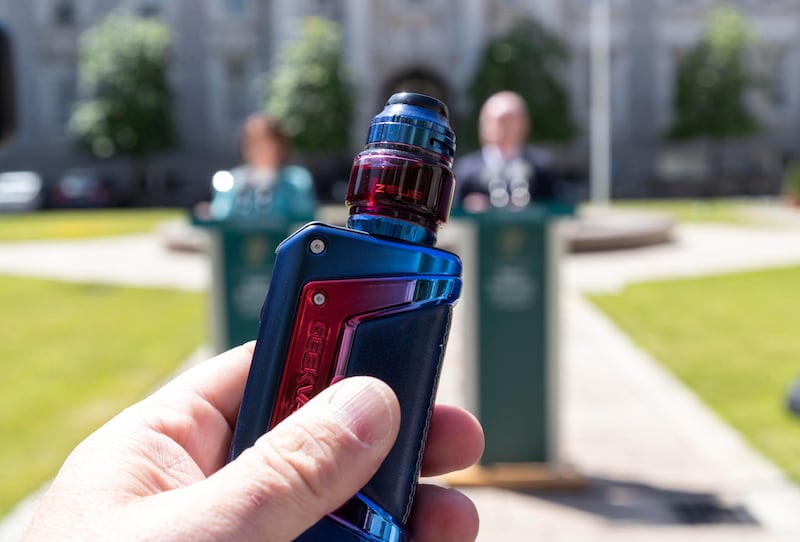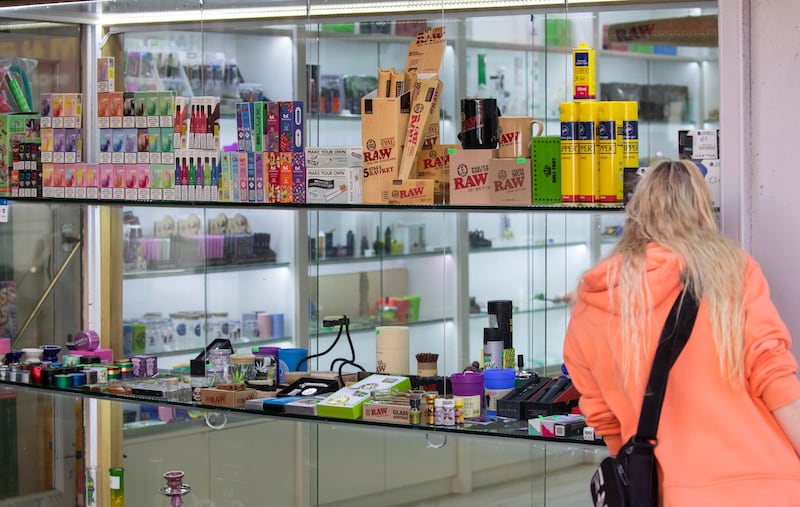In a north Dublin newsagent’s, a mother and her young son are paying for a litre of milk and a bar of chocolate. Behind the cashier is a row of multicoloured boxes, a rainbow-like display.
There are labels on the boxes: pink lemonade, mango, blueberry, sour raspberry, watermelon ice. You wouldn’t know it from the packaging, but they are not designed to be used by children or teenagers.
The vapes, many of which contain nicotine, have been found to have negative consequences on public health, though further research is required to understand the long-term health risks.
But all is due to change on the shop shelves under plans by Government. This week Minister for Health Stephen Donnelly secured Government approval to legislate for further restrictions on nicotine inhaling products.
READ MORE
Under the general scheme, it is proposed there will be a ban on point-of-sale display and advertising in shops other than those that only or primarily sell these products.
There will be restrictions on colours and imagery on packages and devices to make them less appealing to children and young people. Flavour descriptors other than the names of basic flavours will be banned.
There will also be a ban on the import, manufacture and sale of single-use or disposable vapes.
The moves have been welcomed by many health organisations, including the Irish Heart Foundation, which previously described vaping as an “epidemic” among young people and has identified a need for dedicated support to help teenagers and young adults to quit.

The news of the restrictions is a “landmark day”, says Chris Macey, director of advocacy at the charity.
It marks the latest step in trying to reduce the impact of nicotine on public health in the State. The Government is to increase the legal smoking age to 21, while a ban on the sale of disposable vapes to the under-18s was introduced last year.
But how easy will it be to enforce?
Ireland isn’t the only country attempting to clamp down on the use of disposable vapes. The apparent universal desire to ban vapes could make the job easier.
In Denmark there is a ban on all flavourings apart from tobacco flavours. In Belgium, disposable vapes will be banned from the start of next year. Britain and Northern Ireland also intend to ban disposable vapes.
Last March New Zealand’s government announced that it will ban the sale of disposable e-cigarettes, increase fines on retailers that sell to under-18s and better regulate retailers.
All of these countries are still in the early stages of regulation.
Australia is leading the way. Since July reusable vaping devices have been available only with a prescription from a pharmacist. However, the government has rowed back on this, with vapes due to be available to adults on an over-the-counter basis from pharmacists from October.
From then onwards, people in Australia will need to present ID that they are 18 or older and pharmacists will need to counsel those they approve for vapes. Under-18s will still require a prescription.
[ Vaping crackdown: why are ‘serious restrictions’ being rolled out?Opens in new window ]
The concentration of nicotine in vapes sold in pharmacies without a prescription will be limited to 20mg of nicotine per millilitre; people who require vapes with a higher concentration of nicotine will still require a prescription. Flavours will be limited to mint, menthol and tobacco, and all vape products will require plain pharmaceutical packaging.
Retailers and those found to be illegally importing vapes for sale will still face fines of up to 2.2 million Australian dollars (€1.2 million) and up to seven years in prison.
In terms of enforcement, other countries point to a path that the Irish authorities can follow. However, people will inevitably still be able to buy vapes, Minister for Health Stephen Donnelly has acknowledged.

“Will people inevitably be able to purchase things from other countries? To some extent they will. You’re never going to have an absolute – a policy like that is never going to result in a 100 per cent ban any more than, you know, bans on class A drugs,” he said.
“It’s still possible to get class A drugs but it’s obviously a lot more difficult than if they were for sale in the shops. So it’s a similar approach.”
Organisations representing vape sellers have said the proposed legislation is simply going to push the sale of these items underground, creating a black market.
Prof Des Cox, a consultant in paediatric respiratory medicine at Children’s Health Ireland (CHI), said one of the biggest stated concerns around nicotine legislation has been “that the black market will come in”.
However, he predicted that, once legislation restricting vape use comes into force, “the evidence will show there hasn’t been an explosion” of black market sales.
Britain and Northern Ireland intend to introduce similar restrictions on vapes, he said, “which means there will be a cross-Border ban”.
“So people won’t just be able to go up north to get them, so that will make it harder,” Prof Cox said. “The EU is also intending to introduce restrictions on vapes across the bloc.”
However, he believes Government can go further than the current proposals. The plan to increase the legal smoking age to 21 “negates the role of vapes among people under the age of 21″ as a quitting tool, he said. He believes further age restrictions could be implemented.
Aside from health, a significant reason for the clampdown on vapes around the world is environmental: the disposable variety, in particular, is a frequently littered item.
Dr Jason Power, a lecturer at the school of education at the University of Limerick who teaches in the areas of manufacturing, materials and design engineering, said that from a materials, environmental and technology perspective, disposable vapes were “fundamentally a terrible idea”.
“If vapes are improperly included in standard recycling or landfill they can cause fires, which in turn can destroy infrastructure and emit dangerous toxins, he said. “The typical designs are not suitable for easy or automated disassembly, meaning material recovery is not viable.”
However, vaping among children and adolescents is the main reason. Though initially viewed as a safer alternative to smoking, vaping has now become a particular product of choice among young people.
According to last year’s Healthy Ireland Survey – the Government’s annual health survey of the population – a fifth of women and girls aged 15 to 24 in the State use e-cigarettes either daily (11 per cent) or occasionally (9 per cent), making them the biggest users of e-cigarettes. Nine per cent said of males in the same age group said they vaped daily, 7 per cent occasionally.
There is increasing evidence about the risks vaping poses to human health. A recent study from the Royal College of Surgeons in Ireland (RCSI) looked at all 180 known eliquid flavour chemicals, predicting the new compounds formed when these substances are heated within a vaping device immediately before inhalation.
The analysis revealed the formation of many hazardous chemicals, including 127 classified as “acute toxic”, 153 as “health hazards” and 225 as “irritants”.
These included a group of chemicals called volatile carbonyls (VCs), which are known to pose health risks. Sources for VCs were predicted to be the most popular fruit, candy and dessert-flavoured vape products.
Prof Donal O’Shea, head of the Department of Pharmaceutical and Medicinal Chemistry at the Royal College of Surgeons in Ireland, said the combination of flavoured and disposable vapes had “played a significant role in the rapid rise of vaping among younger people, many of whom have never smoked”.
“Ireland has been a global leader in tobacco control, particularly with the indoor smoking ban, and we have the opportunity to lead once again on the issue of vaping,” he said.
“These new laws stand to bring considerable public health benefits and, in the long term, it is unlikely that future generations will thank us for allowing yet another addictive health crisis to take root.”
- Sign up for push alerts and have the best news, analysis and comment delivered directly to your phone
- Join The Irish Times on WhatsApp and stay up to date
- Listen to our Inside Politics podcast for the best political chat and analysis










